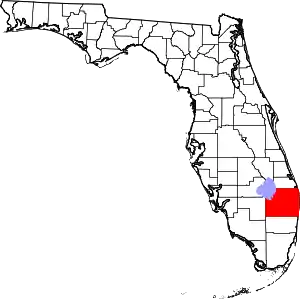Boca Del Mar, Florida
Boca Del Mar was a census-designated place (CDP) in an unincorporated area near Boca Raton in Palm Beach County, Florida, United States. The population was 21,832 at the 2000 census. While it is not officially in the City of Boca Raton, the community is often classified under its umbrella term.
Boca Del Mar, Florida | |
|---|---|
 The location of Boca Del Mar, Florida. | |
| Coordinates: 26°20′42″N 80°8′48″W | |
| Country | |
| State | |
| County | Palm Beach |
| Area | |
| • Total | 4.0 sq mi (10.4 km2) |
| • Land | 4.0 sq mi (10.4 km2) |
| • Water | 0.0 sq mi (0.0 km2) |
| Elevation | 13 ft (4 m) |
| Population (2000) | |
| • Total | 21,832 |
| • Density | 5,430.1/sq mi (2,096.6/km2) |
| Time zone | UTC-5 (Eastern (EST)) |
| • Summer (DST) | UTC-4 (EDT) |
| FIPS code | 12-07235[1] |
| GNIS feature ID | 1867116[2] |
The subdivision was first planned in 1971 as Boca Granada by the Behring Corporation, who previously developed Tamarac Lakes. Ultimately, the name was changed to its current state to avoid confusion of a condo complex in the area, and Leadership Housing, Inc. assumed control after a merger deal. Construction began a year later, and progressed significantly in the 1980s.
Geography
Boca Del Mar is located at 26°20′42″N 80°8′48″W (26.344957, -80.146590),[3] or approximately three miles southwest of Boca Raton.
According to the United States Census Bureau, the CDP has a total area of 10.4 km2 (4.0 mi2), all land.
Demographics
| 1990 | 17,754 |
| 2000 | 21,832 |
As of the census[1] of 2000, there were 21,832 people, 10,911 households, and 5,662 families residing in the CDP. The population density was 2,096.9/km2 (5,430.1/mi2). There were 12,009 housing units at an average density of 1,153.4/km2 (2,986.9/mi2). The racial makeup of the CDP was 94.43% White (87.7% were Non-Hispanic White,)[5] 1.23% African American, 0.05% Native American, 1.88% Asian, 0.03% Pacific Islander, 1.06% from other races, and 1.32% from two or more races. Hispanic or Latino of any race were 8.16% of the population.
There were 10,911 households, out of which 16.5% had children under the age of 18 living with them, 42.2% were married couples living together, 7.4% had a female householder with no husband present, and 48.1% were non-families. 39.9% of all households were made up of individuals, and 17.1% had someone living alone who was 65 years of age or older. The average household size was 1.95 and the average family size was 2.60.
In the CDP, the population was spread out, with 14.4% under the age of 18, 6.3% from 18 to 24, 27.3% from 25 to 44, 24.4% from 45 to 64, and 27.6% who were 65 years of age or older. The median age was 47 years. For every 100 females, there were 83.0 males. For every 100 females age 18 and over, there were 79.2 males.
The median income for a household in the CDP was $52,335, and the median income for a family was $69,531. Males had a median income of $49,013 versus $35,485 for females. The per capita income for the CDP was $36,983. About 1.7% of families and 4.3% of the population were below the poverty line, including 2.5% of those under age 18 and 3.3% of those age 65 or over.
As of 2000, English as a first language accounted for 83.16% of all residents, while Spanish accounted for 8.46%, French was spoken by 1.14%, both Hebrew and Portuguese were totaled at 1.12%, Italian made up 0.99%, German was at 0.89%, Yiddish at 0.84%, both Chinese and Russian were at 0.59%, and French Creole was the mother tongue for 0.44% of the population.[6]
References
- "U.S. Census website". United States Census Bureau. Retrieved 2008-01-31.
- "US Board on Geographic Names". United States Geological Survey. 2007-10-25. Retrieved 2008-01-31.
- "US Gazetteer files: 2010, 2000, and 1990". United States Census Bureau. 2011-02-12. Retrieved 2011-04-23.
- Source: U.S. Census Bureau
- "Demographics of Boca Del Mar, FL". MuniNetGuide.com. Archived from the original on 2007-12-18. Retrieved 2007-12-05.
- "MLA Data Center Results for Boca Del Mar, Florida". Modern Language Association. Retrieved 2007-12-05.

